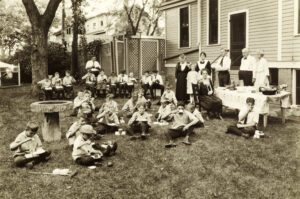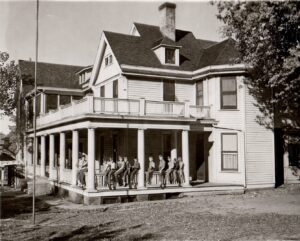Our Journey to 100 Years: The Early Years
To commemorate our milestone 100th anniversary, our series called “Our Journey to 100 Years” continues. In this series, we’re taking you through OHB’s history and highlighting people, events and notable moments that have gotten us to today. The information in this series is gathered from a book that was written by John Carter as a labor of love to chronicle the first 75 years of Omaha Home for Boys.

Here we’re taking a look at the early years from 1920 to 1930.
On March 21, 1921, ten-year-old James King, who had been residing with relatives in the Florence section of North Omaha, became the first boy to move into the Masonic Home for Children, as OHB was known then. Other neglected and wayward boys soon followed and by the end of the first year, the annual report stated that 67 boys from ages five to 15 had been cared for.
Stanford Fadden, the ninth boy to enter the Home, recalls those early days sharing, “Each boy had a daily job. My job was to get up at 4:00 a.m., using my own alarm clock, and go to the coal furnace to shake the clinkers out and put in some fresh coal every day. No one else wanted that job, but I did it because it was quick and didn’t take a lot of time.”
The Home’s first dwelling was located on the northwest corner of 22nd and Davenport Streets and suited the boys well with one exception: it was nearly always full to its capacity of 36. When George W. Megeath approached the board about the use of the Megeath family home at 2137 South 33rd Street, a move was planned. The Megeath House was donated to the Home and just two years after the birth of the Masonic Home for Children, the boys moved to their new home.

The Megeath House was certainly more spacious and grand than the previous house and was described by The Omaha Bee in 1922 as, “one of the most beautifully situated homes in Omaha.” The mansion had 18 rooms including a library, living quarters for the superintendent and his family, a hospital room, and a recreation room with wrestling mats, boxing bags, lockers and showers.
With all this room both inside the beautiful home and on the expansive grounds, possibly the most often used area was the dreaded bench, located just inside the front door, where boys were sent following misbehavior. Oh, if that bench could talk!
The move to the new location brought many changes in the lives of the boys. The older boys began attending the relatively new Technical High School which meant a 3-mile walk north in the morning and a 3-mile walk south in the afternoon. Hanscom Park, then the largest park in the city, was now located just across the street and held a world of fun for growing boys.
And we cannot talk about the Home’s early years without remembering the rich farmland of the J.C. Robinson Seed Company in Waterloo, Nebraska where the boys were taken by Model T to work and make lasting memories. Valuable food was grown for the dining tables and the board began to wonder if securing the Home’s own land would be a worthwhile investment.
As the Roaring 20s came to a close so did the Home’s early years. We had survived the challenges of infancy and the Masonic Home for Children was ready for more.